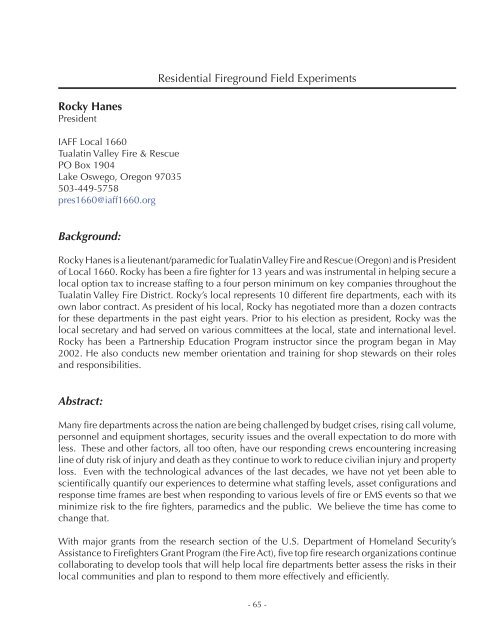Redmond EMS Abstracts.indd - IAFF
Redmond EMS Abstracts.indd - IAFF
Redmond EMS Abstracts.indd - IAFF
Create successful ePaper yourself
Turn your PDF publications into a flip-book with our unique Google optimized e-Paper software.
Residential Fireground Field Experiments<br />
Rocky Hanes<br />
President<br />
<strong>IAFF</strong> Local 1660<br />
Tualatin Valley Fire & Rescue<br />
PO Box 1904<br />
Lake Oswego, Oregon 97035<br />
503-449-5758<br />
pres1660@iaff1660.org<br />
Background:<br />
Rocky Hanes is a lieutenant/paramedic for Tualatin Valley Fire and Rescue (Oregon) and is President<br />
of Local 1660. Rocky has been a fire fighter for 13 years and was instrumental in helping secure a<br />
local option tax to increase staffing to a four person minimum on key companies throughout the<br />
Tualatin Valley Fire District. Rocky’s local represents 10 different fire departments, each with its<br />
own labor contract. As president of his local, Rocky has negotiated more than a dozen contracts<br />
for these departments in the past eight years. Prior to his election as president, Rocky was the<br />
local secretary and had served on various committees at the local, state and international level.<br />
Rocky has been a Partnership Education Program instructor since the program began in May<br />
2002. He also conducts new member orientation and training for shop stewards on their roles<br />
and responsibilities.<br />
Abstract:<br />
Many fire departments across the nation are being challenged by budget crises, rising call volume,<br />
personnel and equipment shortages, security issues and the overall expectation to do more with<br />
less. These and other factors, all too often, have our responding crews encountering increasing<br />
line of duty risk of injury and death as they continue to work to reduce civilian injury and property<br />
loss. Even with the technological advances of the last decades, we have not yet been able to<br />
scientifically quantify our experiences to determine what staffing levels, asset configurations and<br />
response time frames are best when responding to various levels of fire or <strong>EMS</strong> events so that we<br />
minimize risk to the fire fighters, paramedics and the public. We believe the time has come to<br />
change that.<br />
With major grants from the research section of the U.S. Department of Homeland Security’s<br />
Assistance to Firefighters Grant Program (the Fire Act), five top fire research organizations continue<br />
collaborating to develop tools that will help local fire departments better assess the risks in their<br />
local communities and plan to respond to them more effectively and efficiently.<br />
- 65 -

















